Hoyas are stunningly special plants, and can be found growing naturally around tropical and subtropical parts of the country. Hoyas are really quite simple to propagate and grow at home in Australia, whether you want them as a houseplant, or out in the garden.
These flowering semi-succulent vines are great as climbing or trailing vines, and work equally well up trellis, walls, or along the ground, with flowering umbels that produce a range of delicate but memorable fragrances.
In this article, we’ll share everything you need to know in order to grow hoyas successfully in Australian gardens.
More...
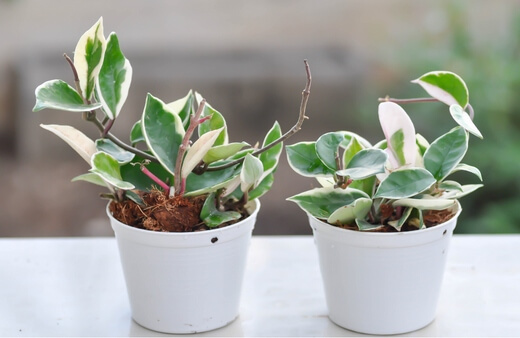
Family: | Apocynaceae |
|---|---|
Genus: | Hoya |
Species: | Over 500 |
Common Names: | Waxplant, Waxvine, Waxflower, Hoya |
Location: | Indoor or outdoor |
Type: | Evergreen perennial vines and creepers (sometimes shrubs) |
Growth: | 18m vines in some species |
Sun requirements: | Full sun |
Foliage Colour: | Green |
Flower Colour: | White or pink |
Flowering: | October to April |
Fruit: | None |
Maintenance level: | Medium |
Poisonous for pets: | Non-toxic to cats and dogs |
Getting to Know the Hoya Plant
Hoyas, also known as wax plants, waxvines or waxflower, are trailing or climbing plants, with vines reaching over 18m in some cases. There are around 300 different species of Hoya found growing around the world, each with different growth rates, eventual heights, leaf shapes and flowering habits.
Thankfully though, all of them can be grown right here in Australia, and will retain their evergreen foliage right through winter, and will survive temperatures down to -5°C, making them a useful plant to add height and structure all year round.
While hoyas grow differently from most succulents, they do store water in their leaves, giving them a distinctly succulent feel. Even thinner leaved hoyas store water, so testing their leaves for rigidity is often a good way to assess overall plant health.
Natural Habitat of Hoya
Hoyas are native to Australia, tropical Asia, including Indo-china, Indonesia and the Pacific Islands.
H. australis, H. macgillivrayi, H. carnosa, and H. serpens are the most commonly grown species that are native to Australia, and prefer hot and humid summers, but warm dry winters, often preferring no water at all in the colder months if they are well kept through spring, summer, and autumn.
20 Best Hoya Varieties to Grow in Australia
With so many types of Hoya to choose from, it’s hard to whittle it down to just a few, but there are definitely some candidates that are far better in Australian gardens than others.
Check the notes for each variety to see if it will cope where you are, as they can vary in hardiness, which is important for cooler parts of the country, and some are very susceptible to winter rot in damp conditions.
1. Hoya australis
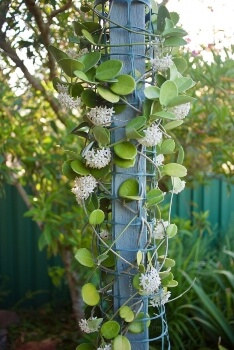
Source: Mallee Design
H. australis is the most recognisable native hoya, with waxy, jade-green leaves that display neatly and evenly all year round along dense, 10 long vines. They grow well indoors but prefer to be outdoors, with some shade from afternoon sun.
- Growth type: climbing
- Frost hardy: partial
- Height/vine length: 10m
- Flower colour: white
- Native: yes
2. Hoya burtoniae
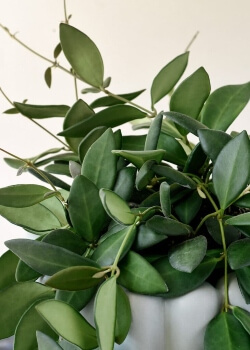
Source: Plant Circle
With subtly variegated leaves, these fleshy hoyas are stunning hanging basket plants. They prefer to climb in nature, but work just as well in trailing situations, or hanging down from pots and window planters.


Get Your Free Guide:
Master Growing Australian Natives eBook
A Must Have Complete Guide for Every Australian Garden
Get Your Free Guide:
Master Growing Australian Natives eBook
A Must Have Complete Guide for Every Australian Garden
- Growth type: climbing or trailing
- Frost hardy: no
- Height/vine length: 2m
- Flower colour: red
- Native: no
3. Hoya carnosa

H. carnosa is a trailing variety that grows much faster outdoors than indoors. It is native to Australia so can withstand most native weather conditions, but is not frost-hardy.
- Growth type: trailing
- Frost hardy: no
- Height/vine length: 5m
- Flower colour: white or pink
- Native: yes
4. Hoya caudata

Source: Wikidata
H. caudata is one of the most widely hybridised hoyas, with dozens of named cultivars, and most are stunning additions to the garden, with wide-ranging variegations. However, they are not at all frost-hardy, and will suffer if temperatures remain below 15°C for more than a week.
- Growth type: climbing
- Frost hardy: no
- Height/vine length: 12m
- Flower colour: pink and white
- Native: no
5. Hoya coronaria

Source: Hoya Store Australia
H. coronaria is a fairly small hoya despite its large, elongated leaves, typically growing to about 1m indoors, or 3m outdoors. Its flowers can range from yellows and pinks to a crisp white, and it will work as either a trailing hanging plant or climber with support.
- Growth type: climbing
- Frost hardy: no
- Height/vine length: 3m
- Flower colour: pink, yellow, or white
- Native: no
6. Hoya diversifolia
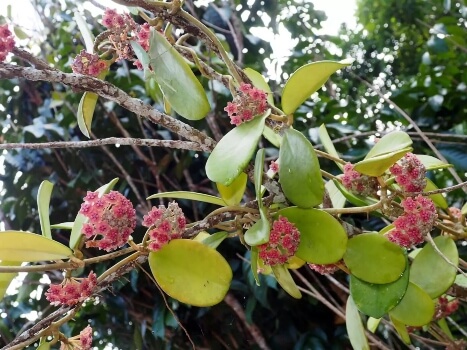
H. diversifolia has stunning flowers, growing in tight umbellifers, with each petal displaying a neatly crimped edge. Their mature vines turn woody but continue to bear flowers. They are hardy down to freeing in dry conditions, but cannot withstand those temperatures for more than a day or two.
- Growth type: trailing
- Frost hardy: no
- Height/vine length: 10m
- Flower colour: pink
- Native: no
7. Hoya finlaysonii
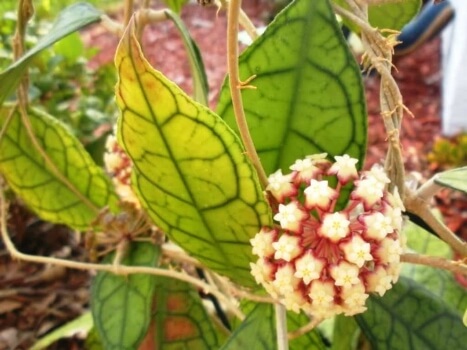
I’m biassed because we have one growing in our bathroom, but H. finlaysonii is one of the best hoyas you can grow. Its stunningly translucent leaves catch the morning lights perfectly, and it thrives in well-ventilated indoor conditions.
It is very frost tender, so growing them indoors is the only way to guarantee success in all but the most tropical parts of the country.
- Growth type: climbing
- Frost hardy: no
- Height/vine length: 3m
- Flower colour: cream, with red or orange tips
- Native: no
8. Hoya fitchii
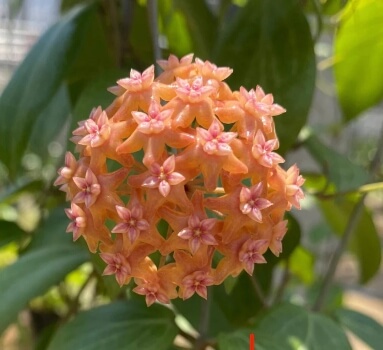
Source: PLANTYANA
H. fitchii is one of the few Malaysian hoyas that can withstand frost for any length of time, tolerating temperatures down to about -1°C through winter. They can be grown as climbers, but tend to look their best hanging from tree branches.
- Growth type: climbing or trailing
- Frost hardy: no
- Height/vine length: 3m
- Flower colour: peach
- Native: no
9. Hoya imperialis
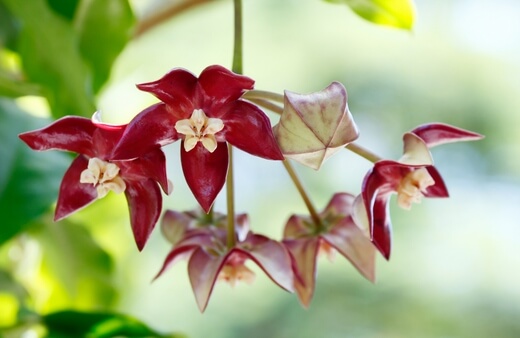
Its strikingly substantial flowers, in looser umbels than most, are what set H. imperialis apart, with deep burgundy shades that stand out from the deep green foliage. H. imperialis is not frost tolerant but can grow happily outdoors in warmer parts of Australia.
- Growth type: trailing
- Frost hardy: no
- Height/vine length: 5m
- Flower colour: red
- Native: no
10. Hoya kentiana
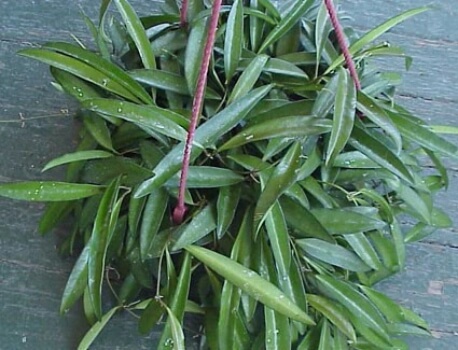
Source: Jordan's Jungle
H. kentiana, and to a large extent, H. kentiana ‘Variegata’ have sparked a renewed interest in this genus over recent years. While they are still relatively rare, their stippled and colourful foliage adds something truly unique to any garden.
They are trailing plants, but at maturity can climb happily through trees, and their mature stems can hold their own weight quite happily.
- Growth type: trailing
- Frost hardy: no
- Height/vine length: 2m
- Flower colour: red or purple
- Native: no
11. Hoya kerrii
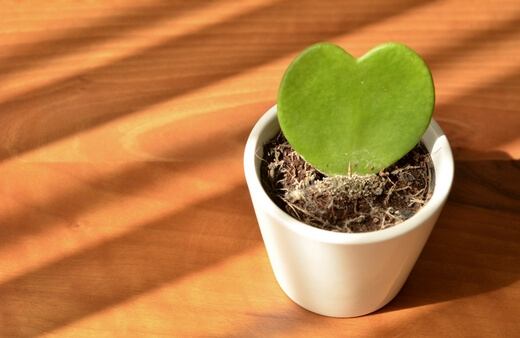
H. kerrii should always be purchased with care and attention. They are often sold as single leaf cuttings around Valentine’s Day, making the most of their heart-shaped leaves, but they do not take or root well.
Check the root inside the pots before buying H. kerrii, and only rooted ones will grow successfully.
- Growth type: climbing or trailing
- Frost hardy: no
- Height/vine length: 4m
- Flower colour: white, with red centres
- Native: no
12. Hoya lacunosa

With elongated leaves and gentle loose flower clusters, H. lacunosa is a wonderful addition to the garden. It can technically climb, but it needs coaxing to do so, so it often works better in hanging baskets in the canopies of trees.
That means they can easily be brought indoors over winter to avoid the risk of frost.
- Growth type: trailing
- Frost hardy: no
- Height/vine length: 2m
- Flower colour: white or cream
- Native: no
13. Hoya linearis
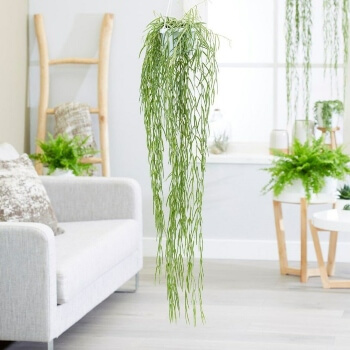
Source: Houseplant Central
The long, cylindrical leaves of H. linearis are undeniably beautiful. Their dense mass of foliage is perfect for indoor and outdoor spaces alike, but it will need protection from temperatures close to freezing, either indoors or in a greenhouse.
- Growth type: trailing
- Frost hardy: no
- Height/vine length: 2m
- Flower colour: white
- Native: no
14. Hoya macgillivrayi
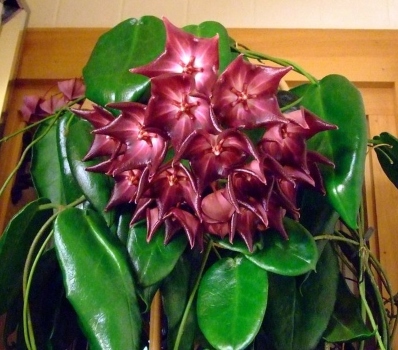
Source: Jane Perrone
In warmer parts of the country, H. macgillivrayi is one of the easiest hoyas to grow, with very little maintenance, and a self-vining habit that will see your hoya reaching for its own perfect conditions.
- Growth type: climbing
- Frost hardy: no
- Height/vine length: 3m
- Flower colour: purple
- Native: yes
15. Hoya memoria
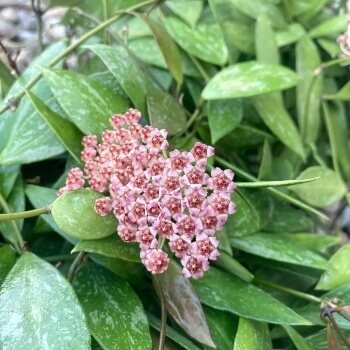
Source: Secret Garden
Also known as Hoya gracilis (though now reclassified), H. memoria has bright leaves with flecks of yellow and white. Its slow-growing habit makes it a useful patio plant that's easy to control, but it will eventually reach 1.5 long on each vine.
- Growth type: trailing
- Frost hardy: no
- Height/vine length: 1.5m
- Flower colour: pink or red
- Native: no
16. Hoya mindorensis
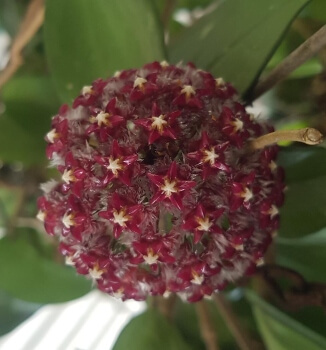
Source: Weslor Flowers Plant Nursery
H. mindorensis is grown for its range of flower colours, more than for its vines or foliage. The leaves of H. mindorensis are a beautiful way to cover fences or tree trunks without damaging them, but their flowers range from yellows, to peach, right through to deep burgundies and almost black.
- Growth type: climbing
- Frost hardy: no
- Height/vine length: 3m
- Flower colour: white and red, or yellow
- Native: no
17. Hoya obovata

Source: Houseplant Central
The round leaved hoya, H. obovata, is sold as variegated cultivars and matt leaved cultivars, though they share the same name as variegations are down to parentage rather than genetic difference.
Their flowers are small, but gorgeous, with bright pink centres surrounded by vivid crystal-white petals.
- Growth type: trailing
- Frost hardy: no
- Height/vine length: 4m
- Flower colour: white and pink
- Native: no
18. Hoya serpens
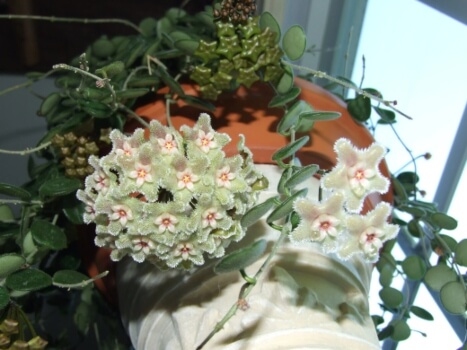
Source: Vermont Hoyas
H. serpens are, we think, native to Himalayan forest canopies, but they have spread naturally to Australia and grow happily in our native conditions. While they are not frost hardy, they work well grown semi-epiphytically, in hanging baskets with coco coir. In warmer regions, they will grow well outdoors all year round.
- Growth type: trailing
- Frost hardy: no
- Height/vine length: 3m
- Flower colour: creamy white
- Native: yes
19. Hoya shepherdii

Source: Ed's Plant Shop
While H. shepherdii is not technically frost tolerant, it does recover well from brief frosts, even if there has been damage. In our garden, we’ve grown H. shepherdii outdoors for several years, and the tips brown and die back in frost but, when cut back, recover well.
- Growth type: trailing
- Frost hardy: no
- Height/vine length: 2m
- Flower colour: white
- Native: no
20. Hoya wayetii
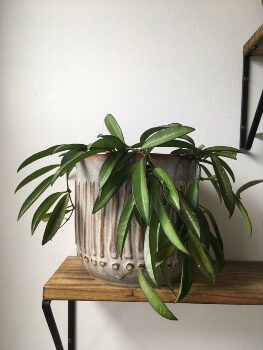
Source: Planta app
H. wayetii is a true collector’s plant. It isn’t as popular as H. kentiana, but its foliage is tougher and denser. You won’t get the same range of variation, but for a more timeless plant, with no over-complicated colours, it’s worth considering.
- Growth type: trailing
- Frost hardy: no
- Height/vine length: 18m
- Flower colour: red
- Native: no
How to Grow Hoya in Australia
Hoyas are tropical and subtropical plants, able to grow along the ground, or epiphytically up trees. That makes them very adaptable in the garden, where they can vine along fences and supports, or add dazzling texture to the bark of mature trees.
Hoyas can also be grown indoors in any part of Australia, and work well as houseplants in pots and containers too, but their growing conditions do need to be carefully managed to avoid overwatering and extreme indoor humidity, as we’ll explore below.

Best Conditions for Planting Hoya Outdoors
The easiest way to grow hoyas, and in many ways the best, is to grow them outdoors, in nature, where they will thrive, and have space to grow to their full height, width, and spread. Most Australian garden soil is fine for hoyas as it is, but some nutrient amendments will help them establish faster.
Soil & Drainage
Hoyas need good drainage, but not completely arid conditions. They like moist, humid environments where their roots have access to water, without sitting in damp soil. If you have very sandy, free-draining soil, add plenty of compost to the planting hole to decrease drainage.
On clay soils, grow hoyas in pots to avoid any chance of waterlogging.
Light & Temperature
Hoyas should be grown in bright light, with about 4 hours of direct morning or evening sun, and shade from the warmest afternoon sun where possible. In most cases, hoyas will actually search for these conditions and will send vines toward trees where they can grow under the shade of the canopy.
In small spaces, or balconies, grow hoyas on west or east-facing walls, where they will get plenty of light, have the support of trellis or wires, and grow vigorously over your vertical surfaces.
Watering Hoya
Through summer, particularly mid-summer when the sun is at its highest, water hoyas at least once a week, and whenever the top inch of soil is dry. In winter, stop watering hoyas, and only water lightly if the soil becomes dry and the leaves are drooping.
Fertiliser & Mulch
There are a few different ways to feed hoyas, and all work pretty well, but I prefer to use slow-release fertiliser, like Osmocote Native Controlled Release Fertiliser. Hoya isn’t particularly picky about nutrients, so any flowering plant food, tropical fertiliser, or organic feed will give them a boost.
You can use compost as a mulch once a year to boost nutrients in spring, or feed them with fertiliser granules in early spring or even late winter, which will provide enough nutrients for most of the growing season.
Pruning Hoya
Hoya are vigorous plants. Once their roots establish, some can reach full maturity in under five years, and often put on about 2ft of growth per year. Thankfully, for indoor growers, hoyas respond well to pruning, and can be cut back to any point on the stem as long as it’s just above a living leaf node.
Prune out any damaged, diseased or dead growth to maintain the health of the plant, and cut back anything that you don’t want to improve its shape.
Growing Hoya Indoors
Finding a balance between humidity and ventilation is often challenging for hoyas indoors, but they are quick to recover from poor conditions, so don’t be afraid to try them in a few different spots before they’re happy.
Humidity & Ventilation
Key to the success of indoor hoyas is ventilation. They are tropical plants that thrive in warm, humid summers, and mild, dry winters. Indoors, humidity is often the other way around, with air conditions drying the house in summer, and central heating adding humidity in winter.
Find a good spot, with windows or natural ventilation, and if you can’t find that in a humid space like a bathroom, regularly mist your hoya (this won’t actually increase humidity, but does add moisture to the air, which will humidify the room in the right temperatures.
Light requirements
Indoor hoyas need the same light levels as outdoor hoyas – bright light, with direct sun in the morning or evening, but protection from the afternoon heat. North-facing windows are too bright, but against a wall in a north-facing room is ideal.
Watering
Water your indoor hoyas about once a week, or whenever the surface of the soil is dry. In humid rooms, this can be less frequent, and often as little as once a month.
Ways to Propagating Hoya
Hoyas can be propagated from seeds or cuttings. Cuttings will take well from both stem and leaf cuttings, but there are some problems with leaf cuttings that we’ll look at in more detail below.
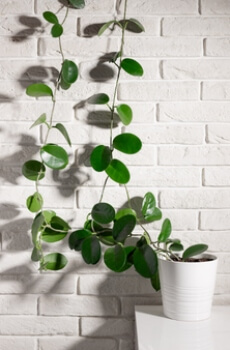
Propagating Hoya from Seeds
You can buy hoya seeds online, but fresh seeds work much more reliably. To harvest your own hoya seeds, tie the end of an old pair of tights around pollinated flowers when seed pods begin to form. Hoya seeds take about two months to fully ripen, so be patient.
When the seed pod bursts open, the seeds will be in the bottom of the tights, ready to sow. Rub the seeds gently over a towel to remove any fibres, so you’re left with clean seeds as excess plant material can rot and damage the seeds after germination.
Once your seeds are clean, simply sow them thinly on the surface of a tray filled with seed compost, then water it by standing it in a tray of water until the surface is damp to the touch. Leave it to drain, and then leave the seed tray somewhere bright and warm for about two weeks.
When seedlings are big enough to handle, prick them out into individual pots.
Hoya Propagation from Stem Cuttings
Hoya stem cuttings have the best success rates, and can be planted out as mature plants by the end of summer for most spring cuttings.
- Start by taking a 10-15cm cutting with 3-4 leaves, or leaf nodes, and no signs of flowers or buds forming.
- Strip the lower leaves, and dip the cut end in rooting powder.
- Bury the cut end in a mix of coir compost, or sieved leaf mould, and about 30% perlite.
- Water it well, and leave it to drain off excess moisture.
- Cover it with a plastic bag, and leave it somewhere bright, but out of direct light.
- It should root within 2 weeks, and be ready to pot on after 1-2 months.
Propagating Hoya from Leaf Cuttings
Hoya leaf cuttings are sold around the country as gifts because many varieties form gorgeous heart-shaped leaves, which can hold their shape for several months without roots. These cuttings rarely take, as they need a section of node to develop roots with any certainty.
To take a hoya leaf cutting that will actually root and produce new vines, you’ll need to remove the entire leaf, with a small section of stem (you can nick this with a knife, to take a ‘tail’ with the leaf, rather than cutting the entire stem off the plant).
Place your cutting, node end down, in very well-draining seed compost, and water until the soil is wet through. Cover with a plastic bag, and mist once a week until it shows signs of growth.
Common Hoya Pests and Diseases
Hoyas rarely suffer from any major pest or disease problems in Australia, but common garden and houseplant pests like aphids, mealybugs, and thrips will cause problems in large enough numbers. If you notice small orange lesions, or areas of white fluffy insects or eggs clustered together, just scrape them off or treat them with rubbing alcohol.
If areas of fungal damage appear on leaves (usually brown with light yellow borders) remove the affected growth and treat the surrounding area with an organic fungicide like neem oil.
The only major problem that will completely kill hoyas in Australia is waterlogging on damp soil, where winter temperatures plummet, matched with raised humidity and rain. In those cases, try to improve the drainage, and if possible move the plant somewhere brighter or sheltered from the rain.
Hoya Frequently Asked Questions

How do you encourage a hoya to grow?
If you are struggling with slow-growing hoyas, indoors or out, it’s worth considering how appropriate their light levels are. Remember, these are naturally epiphytic plants that love bright, but indirect sunlight, and ventilated humidity.
Pruning out overhanging branches may improve their conditions and encourage hoyas to grow.
Do hoyas like to climb or hang?
Every hoya is different, but most prefer to hang down from baskets, or tree branches where possible. If you grow hoyas in pots, allow them to vine around support, before letting their vines hang down from the top.
How do you make a hoya bushy?
Pruning a hoya to make it bushy is simple, but perhaps a little bit counter-intuitive. To increase the bushiness of your plant, you’ll need to thin it out a little first. This means removing about half the growth, back to stems at staggered heights.
This will encourage multiple new shoots and fresh foliage at various points over your hoya.
Do hoyas like big pots?
Hoyas like humid conditions, but that doesn’t mean they like damp soil. They conserve most of their water in their leaves and stems, so don’t plant hoyas in pots that are too big for their roots. Allow about 2-3 cm of space around the root ball when choosing a new pot.
Do Hoyas need deep pots?
Hoyas have shallow roots, so do not need deep pots. Their roots will attach to whatever growing medium they are given, but they do not take much moisture or many nutrients from there, so planting hoya in deep pots can create a lot of damp, empty space, which is a mistake.
Should I bottom water a hoya?
Hoyas can be watered from the top, and do not need to be bottom watered. Bottom watering is a more efficient way to thoroughly water many plants, but hoyas can handle watering from the surface, provided they have a drip tray to catch excess water runoff.
Should I mist my hoya?
There’s a lot of confusion and conflicting information about misting plants, but yes, hoyas do benefit from misting. Humidifiers for your rooms are more effective than misting, but if you cannot constantly humidify your space, misting will slightly increase room humidity.
Alternatively, try placing a bowl of water on top of a radiator to humidify small spaces cheaply.
Is Hoya better with a trellis?
Anything you can provide for climbing hoyas to clamber through will improve their conditions. Hoya is a genus of mostly trailing plants, but they are all capable of climbing through structures and branches to get where they want to be. Trellis is a good way to provide that support.
Choose from our compilation of garden trellis kits and ideas and find out which one could best fit your garden design.
Do you love succulents? If the answer is yes, then you will surely love our compilation of succulents mostly grown in Australia.
Wrapping Up Our Hoya Growing Guide
Whatever variety of hoya you do grow, it should grow well in most parts of the country, both indoors and out, making it an ideal plant to quickly establish native wildlife, and encourage pollinators to the rest of the garden.
Even on trellis around patios, hoyas can provide delicate and dappled shade for seating areas, and won’t mind being open on all sides. With so many ways to grow your own hoyas in Australia, it’s a good choice for any new garden.
Published on February 9, 2023 by Lorri Hopkins
Last Updated on October 18, 2025





Very informative and interesting
Hi Maurie,
I’m glad you found the article informative and interesting.
If you have any questions or need further information about growing and caring for Hoya plants, feel free to ask.
Happy gardening!